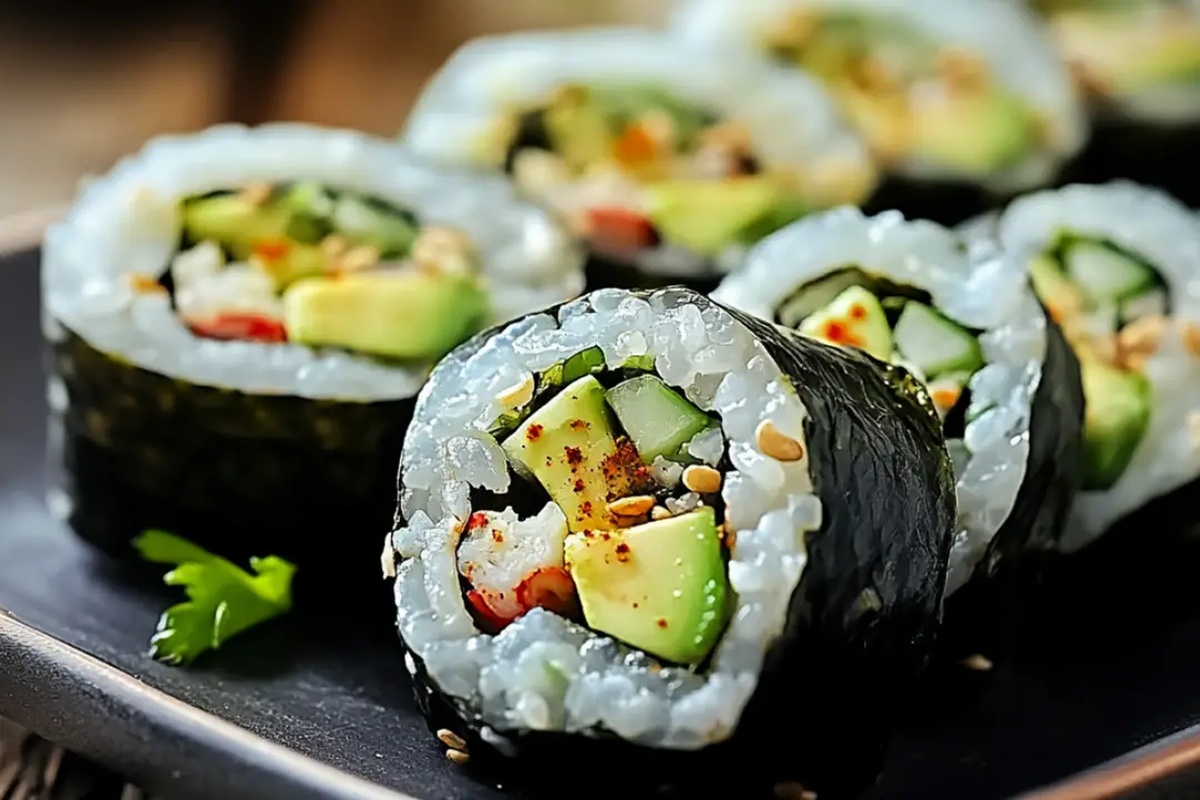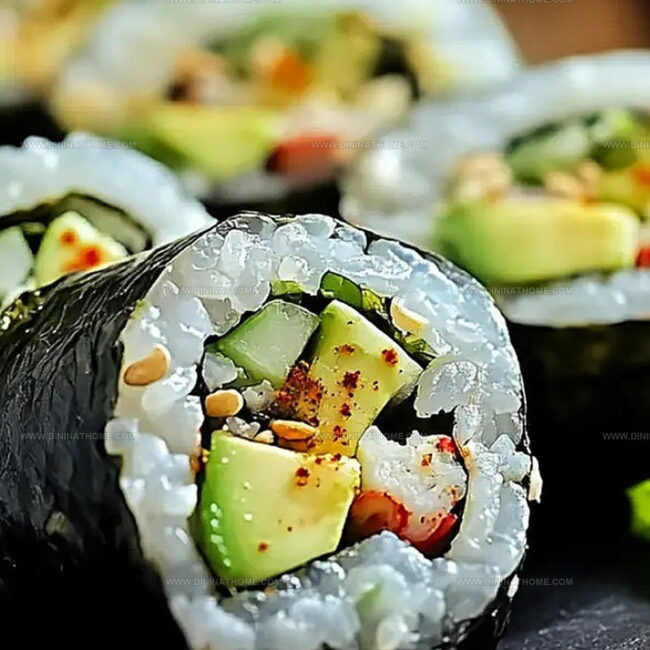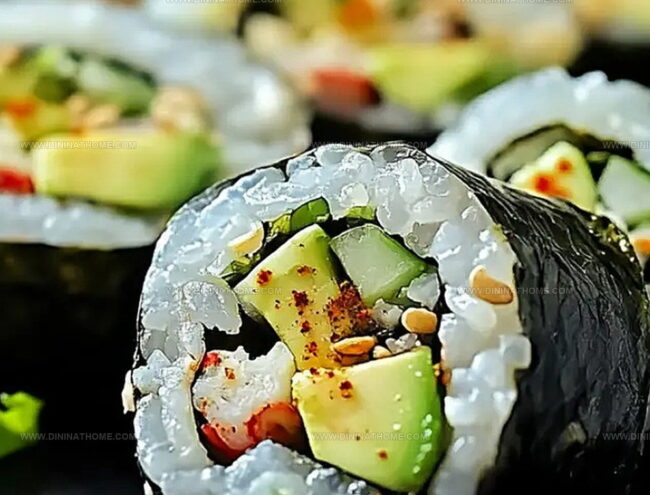Quick & Zesty Vegan Avocado Sushi Rolls Recipe for Maki & Uramaki
Crafting delicious vegan avocado sushi rolls can turn an ordinary meal into a culinary adventure.
Smooth green slices nestled among crisp vegetables create a magical combination.
Nori sheets wrap around perfectly seasoned rice with precision and care.
Ingredients dance together, blending textures and flavors in unexpected ways.
Our kitchen becomes a playground for creative plant-based cuisine.
Delicate rolls promise a refreshing twist on traditional Japanese techniques.
Roll up your sleeves and let’s make some seriously incredible sushi magic happen!
Avocado Sushi Rolls That Are Fresh, Vegan, And Easy To Love
Vegan Avocado Sushi Rolls Ingredient Essentials
Sushi Base Ingredients:Filling and Flavor Ingredients:Garnish and Topping Ingredients:Rolling Vegan Avocado Maki and Uramaki Sushi
Step 1: Prepare Avocado Slices
Grab a ripe avocado and slice it in half.
Remove the pit carefully and create thin, elegant strips.
Splash some citrus juice (lemon or lime) over the slices to keep them looking fresh and prevent browning.
Step 2: Create Traditional Maki Roll
Arrange your bamboo mat and place a nori sheet with the shiny side facing down.
Spread sushi rice across the sheet, leaving a small naked strip at the top edge.
Strategically position avocado strips about a quarter of the way up the rice-covered surface.
Gently roll the sushi using the bamboo mat, using a touch of water to seal the edge perfectly.
Step 3: Design Inside-Out Uramaki Roll
Position a nori sheet on plastic wrap atop your bamboo mat.
Distribute a thin, even layer of rice across the entire sheet.
Sprinkle decorative toppings like sesame seeds for extra texture.
Carefully flip the sheet, nestle avocado slices inside, and roll with precision using the bamboo mat.
Step 4: Slice Sushi Masterpiece
Select a sharp knife and moisten the blade.
Slice the rolled sushi into bite-sized pieces with smooth, confident strokes.
Arrange beautifully on a serving plate.
Vegan Sushi Tips for Rolling Avocado Perfection
Store Vegan Avocado Sushi Rolls
Light Pairings for Vegan Avocado Sushi Rolls
Avocado Sushi Roll Modifications
FAQs
You’ll need nori sheets, sushi rice, ripe avocados, sesame seeds, lemon/lime juice, rice vinegar, bamboo mat, plastic wrap, and a sharp knife.
While possible, brown rice might not stick as well and could make rolling challenging. Sushi rice is recommended for the best texture and rolling experience.
Immediately drizzle freshly cut avocado slices with lemon or lime juice. The citrus acid helps maintain the bright green color and prevents oxidation.
A bamboo mat is helpful but not mandatory. You can use plastic wrap or a clean kitchen towel as an alternative for rolling. A sharp knife is crucial for clean, precise cuts.
Print
Vegan Avocado Sushi Rolls (Maki And Uramaki) Recipe
- Total Time: 20 minutes
- Yield: 2 1x
Description
Delightful vegan avocado sushi rolls blend Japanese culinary artistry with plant-based creativity, bringing creamy textures and fresh flavors to your plate. Rolled with precision and packed with nutritious ingredients, you’ll discover a delicious plant-powered twist on classic sushi that satisfies and surprises.
Ingredients
Main Ingredients:
- 1 nori sheets
- 1 cup (240 milliliters) sushi rice
- 1 medium avocado
Rice Preparation Ingredients:
- 2 tablespoons rice vinegar
- 1 tablespoon sugar
- 1/2 teaspoon salt
Optional Garnish and Serving:
- 1 tablespoon sesame seeds
- 1 tablespoon soy sauce (for serving)
- 1 tablespoon wasabi paste (optional)
- 1 tablespoon pickled ginger (optional)
Instructions
- Carefully slice ripe avocado into delicate, uniform strips, ensuring each piece maintains its vibrant green hue. Protect freshness by gently coating with citrus juice to prevent oxidation.
- Position bamboo mat and place nori sheet with glossy surface facing downward. Distribute sushi rice evenly across seaweed, maintaining a small bare margin along the upper edge for seamless sealing.
- Strategically arrange avocado strips across the rice landscape, positioning them approximately one-quarter from the bottom edge of the nori sheet.
- Utilize bamboo mat’s flexibility to craft a tight, cylindrical form, applying gentle pressure to create a compact roll. Moisten exposed nori edge with water to secure the seam.
- For uramaki variation, layer clean plastic wrap atop bamboo mat. Spread rice uniformly across entire nori surface, creating a thin, consistent coating. Optionally dust with toasted sesame seeds for added texture.
- Invert rice-covered nori, positioning avocado slices centrally for balanced filling. Execute precise rolling technique, leveraging bamboo mat’s guidance.
- Cleanse sharp knife with water between each cut to ensure pristine, clean slices. Slice rolls into bite-sized segments, maintaining aesthetic symmetry and uniform thickness.
Notes
- Perfectly ripe avocados are key to achieving creamy, smooth texture in your sushi rolls.
- Using cold rice helps maintain the ideal sticky consistency and prevents mushy rolls.
- Dip your knife in water between cuts to create clean, precise sushi slices without sticking.
- Experiment with additional vegan fillings like cucumber, carrots, or tofu for extra flavor and nutrition.
- Prep Time: 10 minutes
- Cook Time: 10 minutes (if rice is not yet cooked)
- Category: Lunch, Snacks
- Method: Rolling
- Cuisine: Japanese
Nutrition
- Serving Size: 2
- Calories: 350
- Sugar: 0.5 g
- Sodium: 10 mg
- Fat: 9 g
- Saturated Fat: 1.5 g
- Unsaturated Fat: 7 g
- Trans Fat: 0 g
- Carbohydrates: 62 g
- Fiber: 6 g
- Protein: 7 g
- Cholesterol: 0 mg




James Walker
Lead Recipe Developer & Culinary Educator
Expertise
Southern Cuisine & Farm-to-Table Cooking, Recipe Development & Testing, Culinary Education & Instruction
Education
School: Auguste Escoffier School of Culinary Arts
Program: Diploma in Culinary Arts and Operations
Focus: Comprehensive training in classical and modern culinary techniques, kitchen operations, and farm-to-table practices.
James didn’t learn cooking from a TV show, he learned it from busy kitchens, family gatherings, and long afternoons spent testing recipes the hard way.
After training at the Auguste Escoffier School of Culinary Arts, he brought his love for real, down-to-earth food to every dish he makes.
At Dining At Home, James loves building recipes that feel familiar but still have something special, like adding a twist to a classic or making a slow Sunday dinner feel brand new.
When he’s not in the kitchen, you’ll probably find him swapping garden tips at the farmers’ market or teaching his daughter how to flip pancakes without a mess (almost).